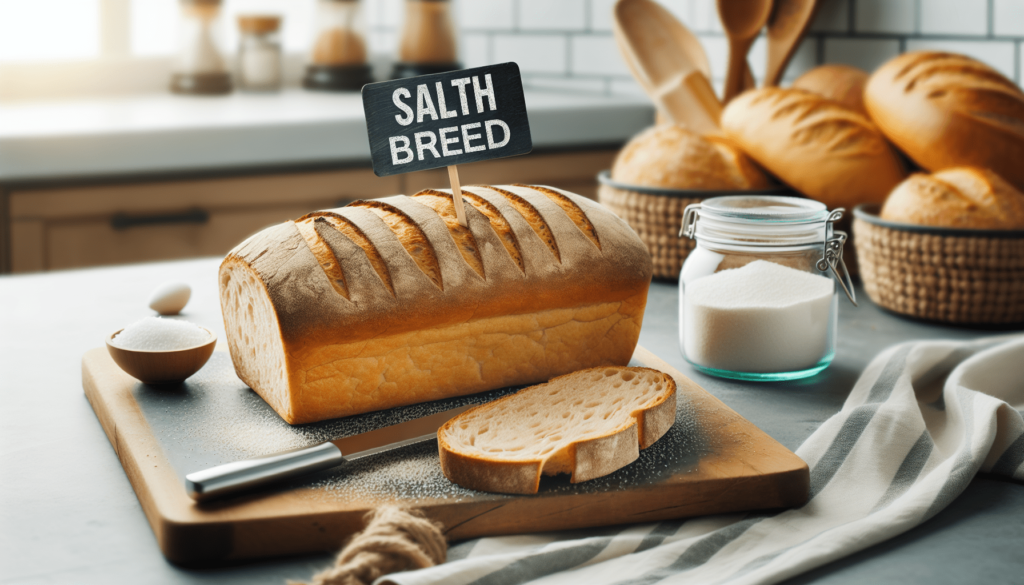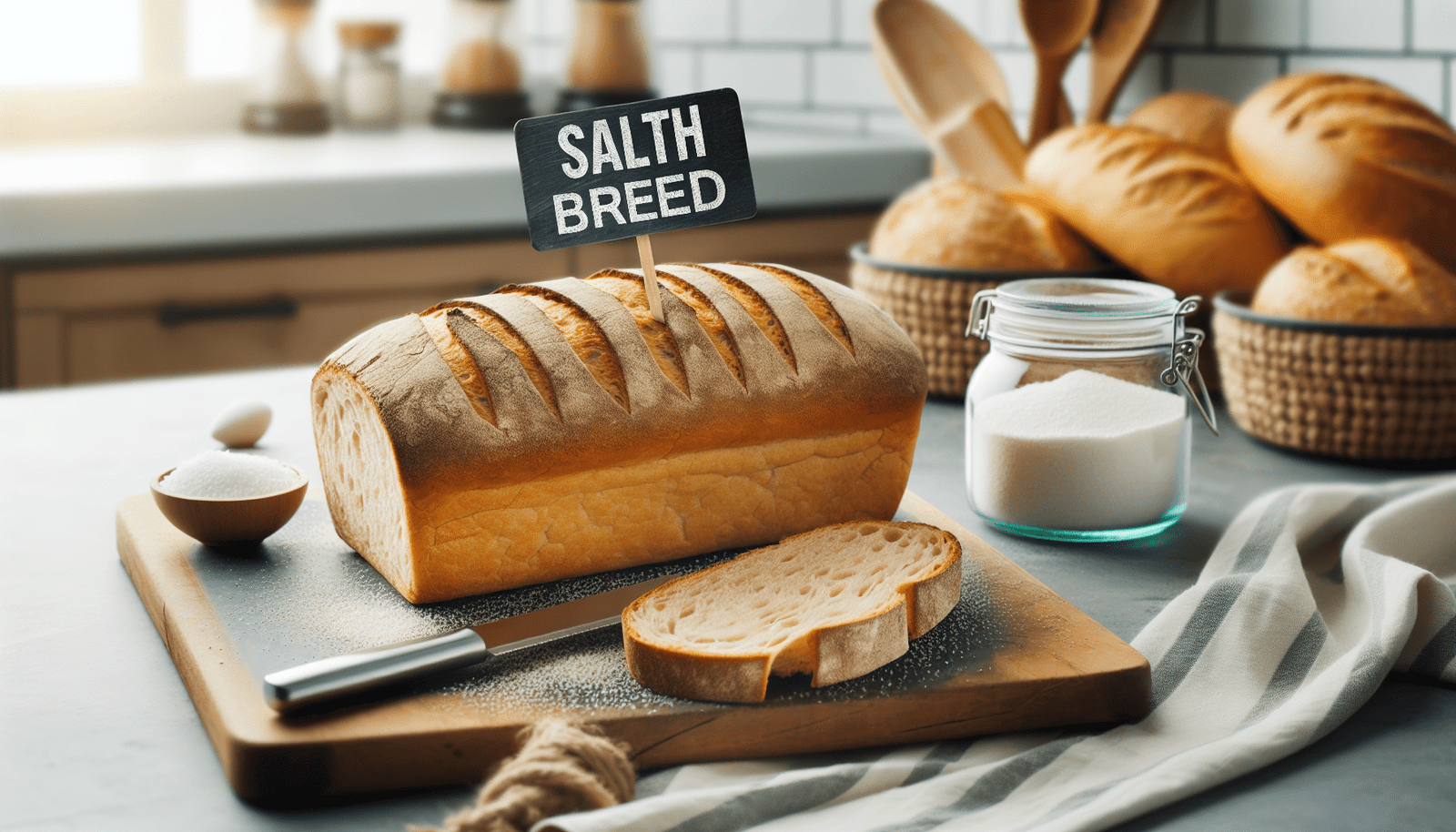If you’re looking for a delicious and healthy alternative to regular bread, then this Salt Free Bread Recipe is for you. Say goodbye to the overpowering taste of salt and embrace a bread that is both satisfying and good for you. With simple ingredients and easy steps, you can make your own fresh loaf of bread that is perfect for sandwiches, toast, or just enjoying on its own. Get ready to experience the goodness of homemade bread without the salt!
Ingredients
To make salt-free bread, you will need the following ingredients:
Flour
- You will need around 4 cups of all-purpose flour or bread flour.
- Bread flour is recommended for better texture and rise.
Yeast
- Use 2 and ¼ teaspoons of active dry yeast or instant yeast.
- This will help the bread dough to rise and create a light and fluffy texture.
Sugar
- Add 2 tablespoons of granulated sugar to provide food for the yeast.
- The yeast will feed on the sugar, helping the dough to rise.
Water
- Use 1 and ¾ cups of warm water.
- The water should be around 110°F (43°C) to activate the yeast.
Oil
- You will need 2 tablespoons of oil, such as vegetable oil or olive oil.
- The oil will add moisture and flavor to the bread.
Preparation
Before you start making the bread, there are a few preparation steps you need to complete:
Dissolving yeast
- In a small bowl, dissolve the yeast in warm water.
- Let it sit for about 5 minutes until it becomes frothy.
Mixing dry ingredients
- In a large mixing bowl, combine the flour and sugar.
- Mix well to evenly distribute the sugar.
Adding wet ingredients
- Add the dissolved yeast mixture and the oil to the bowl of dry ingredients.
- Stir until a rough dough forms.
Kneading the dough
- Transfer the dough onto a lightly floured surface.
- Knead the dough for about 10 minutes until it becomes smooth and elastic.
- This process helps to develop gluten in the dough.
Letting the dough rise
- Place the dough in a greased bowl and cover it with a clean kitchen towel or plastic wrap.
- Allow the dough to rise in a warm place for about 1 to 1.5 hours until it doubles in size.
- The rising time may vary depending on the room temperature.

Shaping and Baking
Once the dough has risen, it is time to shape and bake the bread:
Dividing the dough
- Punch down the risen dough to release any air bubbles.
- Divide the dough into equal portions based on the desired size of your loaves.
Shaping the loaves
- Take one portion of the dough and shape it into a loaf.
- Place the shaped loaf onto a greased or parchment-lined baking sheet.
- Repeat the process with the remaining dough portions.
Proving the dough
- Cover the shaped loaves with a kitchen towel and let them rise for another 30 to 45 minutes.
- The loaves should increase in size and become slightly puffy.
Baking the bread
- Preheat the oven to 375°F (190°C).
- Bake the loaves in the preheated oven for about 25 to 30 minutes until they turn golden brown.
- The bread should sound hollow when tapped on the bottom.
Variations
If you’re looking to add some variety to your salt-free bread, here are a few variations to try:
Whole wheat bread
- Substitute half or all of the all-purpose flour with whole wheat flour.
- This will add a nutty flavor and increase the nutritional value of the bread.
Multigrain bread
- Add a mixture of grains and seeds to the dough.
- You can include oats, flaxseeds, sesame seeds, or sunflower seeds.
- This will add texture and a hearty taste to the bread.
Herb bread
- Add dried herbs such as rosemary, thyme, or basil to the dough.
- This will infuse the bread with aromatic flavors and make it perfect for dipping in olive oil or soups.
Seeded bread
- Coat the shaped loaves with a mixture of various seeds.
- Sesame seeds, poppy seeds, or pumpkin seeds are great options.
- The seeds will add a crunchy texture to the bread’s crust.

Tips and Tricks
To ensure the best results when making salt-free bread, consider the following tips and tricks:
Use bread flour for better texture
- Bread flour has a higher protein content than all-purpose flour, which helps to create a lighter and chewier texture in the bread.
- If you don’t have bread flour, you can still use all-purpose flour with good results.
Proof the yeast for optimal results
- Dissolving the yeast in warm water and letting it sit for a few minutes allows it to activate properly.
- If the yeast doesn’t become frothy, it may be old or the water temperature is incorrect.
Experiment with different oils for taste
- The type of oil you use can impact the flavor of the bread.
- Vegetable oil is a neutral option, while olive oil adds a hint of fruity flavor.
- You could also try coconut oil or avocado oil for a unique taste.
Add herbs and spices for more flavor
- To enhance the taste of your salt-free bread, consider adding dried herbs or spices to the dough.
- This will not only add a delicious aroma but also elevate the overall flavor profile of the bread.
Frequently Asked Questions
Here are some common questions related to salt-free bread:
Can I use gluten-free flour?
- Yes, you can use gluten-free flour to make salt-free bread.
- Look for a gluten-free flour blend specifically designed for bread-making.
- Keep in mind that gluten-free bread may have a slightly different texture than bread made with wheat flour.
Why does bread need salt?
- Salt not only enhances the taste of bread but also helps to control yeast activity and improve the texture.
- However, if you’re on a low-sodium diet or have dietary restrictions, salt can be omitted without compromising the overall quality of the bread.
How long does the bread last?
- Salt-free bread is best consumed within a few days of baking.
- Store it in an airtight container or a plastic bag to keep it fresh.
- If needed, you can slightly warm the bread in the oven before eating to refresh it.
Can I freeze the bread?
- Yes, you can freeze salt-free bread.
- Once the bread has cooled completely, slice it and place the slices in a freezer bag or container.
- It can be stored in the freezer for up to 3 months.
- To thaw, simply take out the desired number of slices and let them defrost at room temperature or briefly toast them.
Benefits of Salt Free Bread
There are several benefits to choosing salt-free bread:
Reduced sodium intake
- Salt-free bread allows you to reduce your sodium intake, which is beneficial for individuals with certain health conditions or those adhering to a low-sodium diet.
- Excessive sodium consumption can lead to high blood pressure and other health issues, so opting for salt-free alternatives can be a healthier choice.
Suitable for certain dietary restrictions
- Salt-free bread is a suitable option for individuals following a low-sodium diet or those with conditions like hypertension or kidney disease.
- By eliminating salt from the bread, it becomes more compatible with specific dietary requirements.
Can be enjoyed by those with high blood pressure
- For individuals with hypertension or high blood pressure, reducing salt consumption is crucial.
- Salt-free bread allows them to enjoy freshly baked bread without worrying about their sodium intake.
Conclusion
Salt-free bread is not only a healthy option but also a delicious one. By following this simple recipe and using the suggested variations, you can enjoy homemade bread that is free of salt while still maintaining the taste and texture you love. Whether you have dietary restrictions or simply want to reduce your sodium intake, salt-free bread is a fantastic choice. So go ahead, give it a try, and enjoy the goodness of homemade bread without compromising your health!


